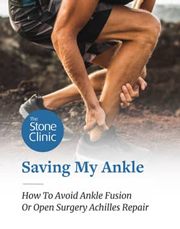Ankle Cartilage Surgery Recovery Time Rehabilitation Protocol
Recovering from an ankle cartilage injury? This step-by-step guide outlines The Stone Clinic’s advanced rehabilitation approach, detailing key milestones, exercises, and recovery timelines to help you regain strength and mobility after our Articular Cartilage Paste Graft Ankle (Talar Dome) procedure.
GENERAL
- Non- weight bearing x 4 weeks with use of crutches or scooter
- Surgical ankle will be in posterior splint immobilizer during weeks 1-4 then transition to stabilization brace
- Avoid direct palpation of surgical portals x 4 weeks, “no touch zone” around portals x 4 weeks
- Passive and Active Range of Motion may be restricted on a case-by-case basis and is dependent on location of lesion
- Low impact for activity only until 9-12 months but only if cleared by Dr. Stone
- Use of the Continuous Passive Motion Device (CPM) for 4-6 hours a day for 4 weeks
Phase 1: Max Protection for Early Recovery After Ankle Cartilage Surgery (Weeks 1-2)
- Weight-bearing status: Non-weight bearing
- Immobilization: Posterior splint
- Range of Motion (ROM): AROM and PROM as tolerated, goal of increasing ROM
- Manual Therapy:
- Effleurage to ankle and lower limb
- PROM within restrictions
- Avoid direct palpation to portals
- Recommended Exercises:
- Toe curls, toe extensions
- Well-leg cycling, well-body weight training
- Ankle isometrics in all directions
- Multi-directional straight leg raises
- Goals:
- Minimal swelling
- Pain < 3/10
- Neutral ankle position achieved pain-free
Phase 2: Moderate Protection for After Ankle Cartilage Surgery (Weeks 3-4)
- Weight-bearing status: Non-weight bearing
- Immobilization: Posterior splint (night use only)
- ROM: Continued progression as tolerated
- Manual Therapy:
- Effleurage to ankle and lower limb
- PROM within restrictions
- Intermetatarsal and midtarsal joint mobilization
- Guidelines:
- Non-weight bearing for 4 weeks (use of crutches or scooter)
- Transition to stabilization brace after 4 weeks
- Avoid direct palpation of surgical portals for 4 weeks
- Use Continuous Passive Motion (CPM) device for 4-6 hours/day for 4 weeks
- Low-impact activity only until 9-12 months (if cleared by doctor)
Phase 3: Weight Bearing Introduction and Strengthening After Ankle Cartilage Surgery (Weeks 5-6)
- Weight-bearing status: Transition from non to full weight-bearing (stabilization brace)
- ROM: Continue progression as tolerated
- Manual Therapy:
- Passive mobilization in all planes
- Gentle mobilization of talocrural & subtalar joints
- Soft tissue mobilization to lower limb musculature
- Recommended Exercises:
- Heel raises
- Straight leg raises
- Mini squats
- Double leg press
- Gait training
- Single-leg balance and proprioception
- Stationary cycling (light resistance, slow cadence)
- Pool exercises (once incisions are closed)
- Swimming (after 12 weeks, without splint)
- Goal: Normal gait pattern
Phase 4: Endurance and Full Recovery Time for After Ankle Cartilage Surgery (Weeks 7-16)
- Weight-bearing status: Full weight-bearing as tolerated
- Bracing: Begin weaning from ankle brace at 8 weeks
- ROM: Continue progression to full range
- Manual Therapy:
- Passive mobilization in all planes
- Gentle mobilization of talocrural & subtalar joints
- Soft tissue mobilization to lower limb musculature
- Recommended Exercises:
- Heel raises
- Straight leg raises
- Mini squats
- Double leg press
- Gait training
- Single-leg balance and proprioception
- Stationary cycling (increase resistance as tolerated)
- Swimming (after 12 weeks)
- Goals:
- Full range of motion
- Normal gait pattern
- Able to perform 25 double-leg heel raises
- Pass fitness test at 12 weeks
NOTE: Please note that the recovery timelines outlined here are specific to The Stone Clinic’s rehabilitation approach, which emphasizes active recovery and advanced techniques. Other clinics may follow more conservative timelines.
Additionally, all progressions are approximations and should be used as a guideline only. Recovery will vary based on individual patient presentation, which is continually assessed throughout the treatment process. Always consult your surgeon or physical therapist for guidance tailored to your specific case
Here's Our Alternative to Ankle Fusion Surgery
BioAnkle. A breakthrough in ankle reconstruction. No implants. No screws. Just biologic healing designed to regenerate cartilage and restore movement naturally. Head here to learn more about our BioAnkle program.
